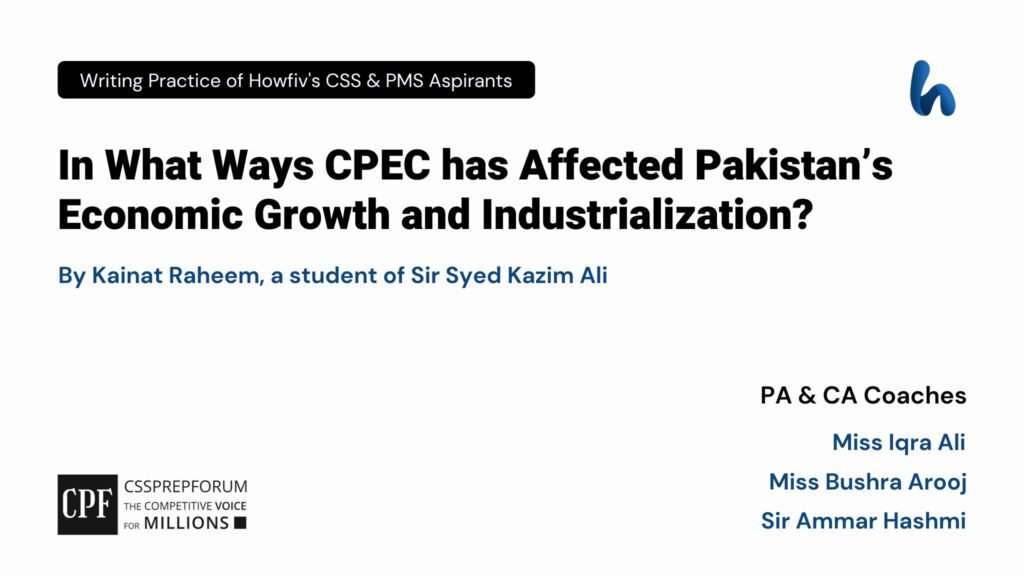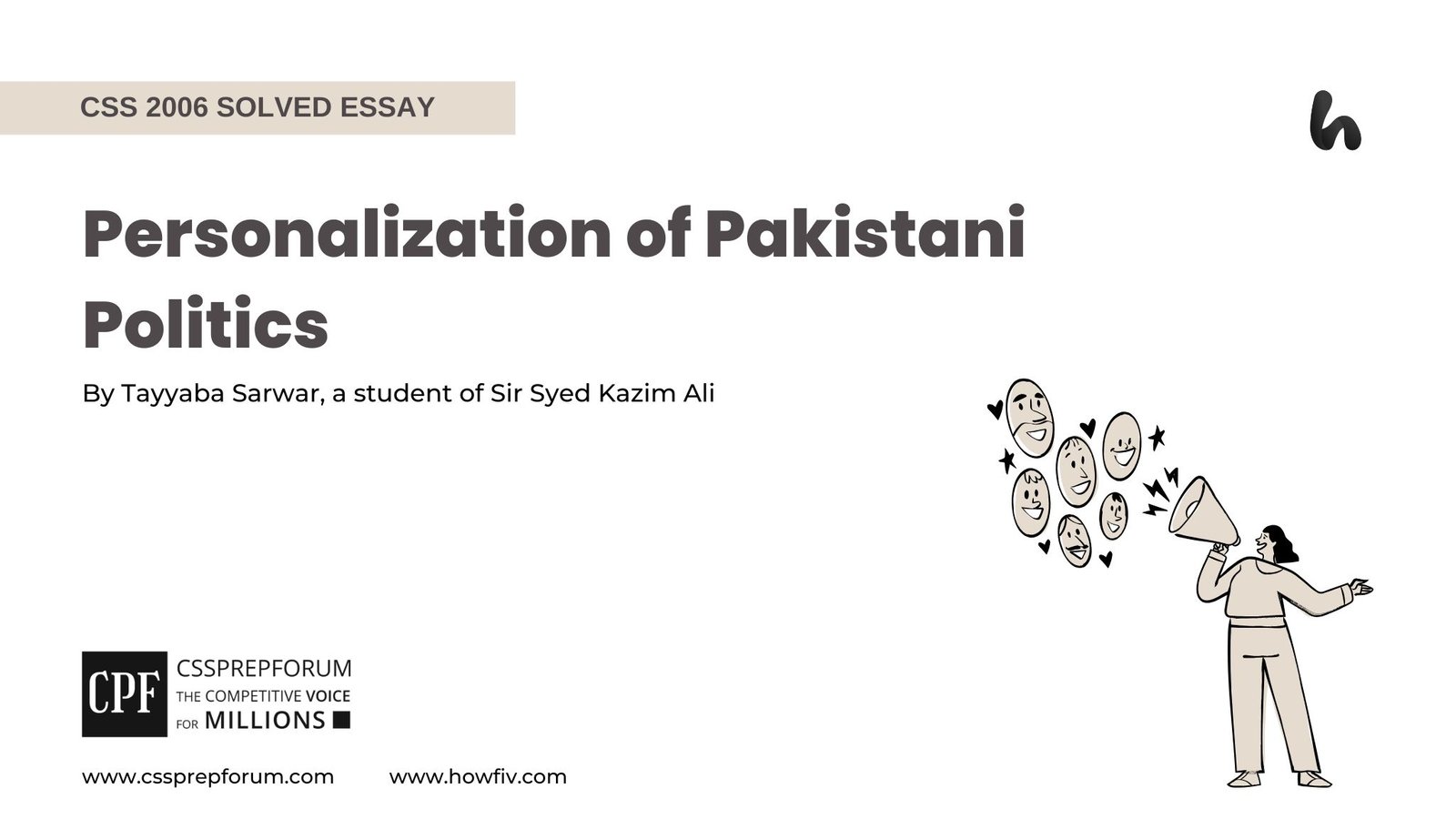CSS Pakistan Affairs | CPEC effects on Pakistan’s Economic Growth and Industrialization
The following question of CSS Pakistan Affairs is solved by Kainat Raheem under the supervision of Howfiv’s Pakistan Affairs and Current Affairs Coaches: Miss Iqra Ali and Sir Ammar Hashmi. She learnt how to attempt 20 marks question and essay writing from Sir Syed Kazim Ali, Pakistan’s best CSS and PMS English essay and precis teacher with the highest success rate of his students. This solved question is attempted on the pattern taught by Sir to his students, scoring the highest marks in compulsory and optional subjects for years.

Introduction
China Pakistan Economic Corridor (CPEC), a pilot project of Belt and Road Initiative (BRI), is considered to be a game-changer for Pakistan’s dwindling economy. Through multi-billion dollar investments in Pakistan in infrastructure development, energy projects, Special Economic zones and communication network, CPEC aims to address Pakistan’s chronic energy shortages, modernize its industrial base, and positions the country as a critical trade and economic hub linking South Asia, Central Asia, and the Middle East and beyond. Moreover, CPEC is expected to boost economic growth by modernizing agriculture, promoting tourism and facilitating technology transfer. Thus, CPEC holds enormous potential to spur economic growth and strengthen Pakistan’s industrial sector.

History of CPEC: bird’s-eye view
Launched in 2013 by China’s president Xi Jinping as a part of the Belt And Road Initiative (BRI), CPEC is a multifaceted project involving total of 60 billion dollar investments in keys areas, including infrastructure, transportation, energy, and industrial development. CPEC is divided into three phases: the early harvest phase, (2015-2020), focusing on energy projects and major transportation networks, Medium- term Phase (2020-2025), prioritizing special economic zones and trade facilitation, and long-term phase (2025-2030), consolidating economic integration and regional connectivity.. Moreover, the project consist of four main routes including northern central, western, and eastern, traversing entire country and connecting China’s southern region Xinjiang to Pakistan’s Gwadar port, the strategic convergence point of all routes. In Short, CPEC not only accelerates Pakistan’s economic growth but also position the country as an important player in regional connectivity and economic cooperation.
Current status of CPEC in Pakistan
The China-Pakistan Economic corridor (CPEC) has brought significant progress and new opportunities. As of 2025, 43 projects worth over $24 million have been completed including power plants, highways, and New Gwadar International Airport. Howerver, local dissatisfaction in areas like Gwadar and Balochistan highlights the need for inclusive development. Despite these challenges, Pakistan and China have reaffirmed their commitment to accelerating through renewed focus on security, and governance. Thus, several projects are underway leading to the economic growth and industrialization of Pakistan.
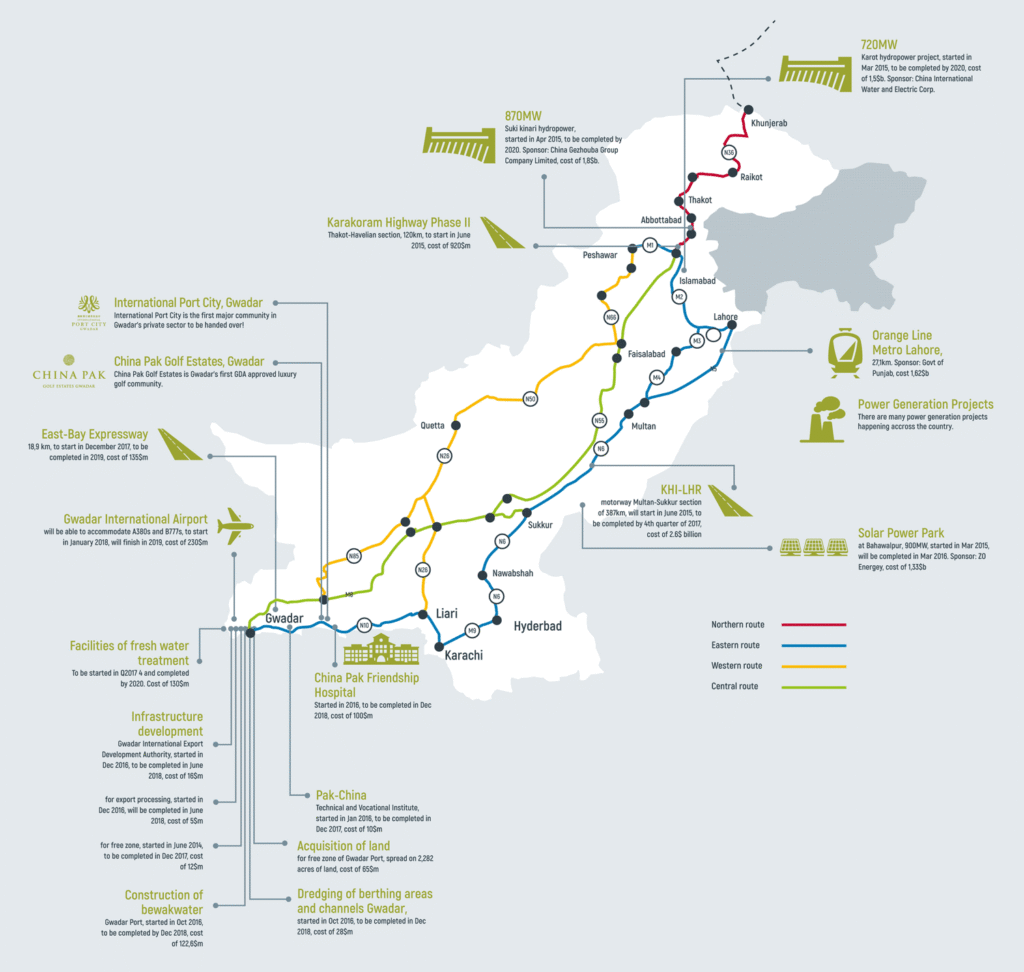
How CPEC has affected Economic and industrial growth in Pakistan
- Development of infrastructure and integration of transport networks to boost trade and expand revenue
Being crucial for economic growth of a country, infrastructure has been a primary focus of the CPEC. The construction of Motorways, Highways, railways, and information network has significantly transformed the infrastructure landscape of Pakistan. Highways and motorways connecting major cities and ports facilitate faster movement of goods and services reducing transportation costs. For Instance, the Karakorum Highway (KKH) of spanning 120KM and connecting Hawelian to Thankot was completed in phase 2. Another example is the 297- km motorway From Hakla to D.I Khan. Therefore, CPEC not only links China with Pakistan opening direct trade route between two countries, but also connects Pakistan with central Asia and beyond fostering regional trade. The Integrated transport system with 22 toll plazas equipped with the latest intelligent technology and 11 interchanges is expected to increase tax revenues. Moreover, the development of Gwadar Port increases the maritime trade capacity of Pakistan. Thus, Infrastructure developments under CPEC attract foreign Direct Investment and boost economic growth in Pakistan.
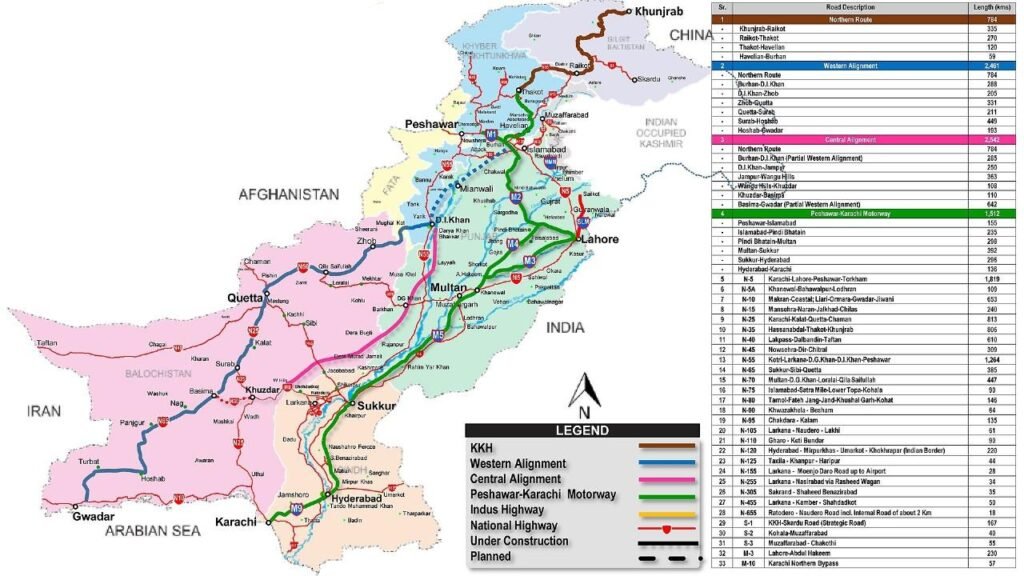
- Achievement of energy security and revival of economic activity
An Efficient and uninterrupted energy supply is vital for economic growth and industrialization. Therefore, energy projects are included in CPEC on priority bases. Energy projects under CPEC include both renewable and non-renewable projects, adding total capacity of 11,110 MW. For Instance, the Suki-Kinari hydropower project, a renewable project, adds 884 MW to the national grid of Pakistan. In non-renewable sector, the China Hub Coal power project in Baluchistan adds 1320 MW of capacity. The energy supply from these projects reduces load shedding ensuring a steady energy supply. Moreover, reliable energy supply through renewable energy sources reduces Pakistan’s dependence on costly imported fuels making energy production more cost effective. Additionally, with fewer power outages, factories can operate at full capacity, increasing output and ultimately encouraging both local and foreign investors. In short, Energy production under CPEC addresses Pakistan’s chronic energy issues and boost economic growth and industrialization.
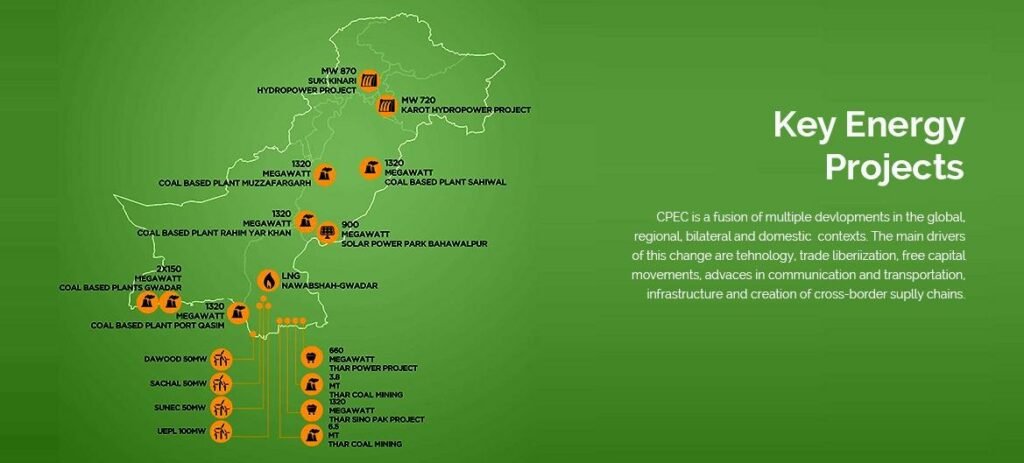
- Attraction of Foreign Direct Investment
Foreign Direct Investment (FDI) stimulates economic growth by bringing capital, which, in turn, enhances production capacity and increases employment opportunities. Under CPEC, Pakistan has attracted a substantial US$ 62 billion in Chinese FDI across various projects. This influx of capital has further deepened economic ties between Pakistan and China, leading to increased bilateral investments and cooperation. It has also improved Pakistan’s international image encouraging foreign investors. Moreover, the establishment of Special Economic Zones (SEZs) under CPEC offers incentives like tax breaks and infrastructure support, making it an attractive destination for investors. For example, the Rashakai Special Economic Zone situated in Khyber Pakhtunkhawa is already attracting investments from different countries. Similarly, upgraded infrastructure and energy projects have reduced operational costs, further enhancing Pakistan’s competitiveness as an investment hub. Hence, CPEC has attracted significant Foreign Direct Investment FDI, thereby accelerating economic growth and industrialization.
- Promotion of tourism and hospitality
Tourism plays an essential role in economic growth by boosting revenue, creating employment opportunities and promotion cultural exchange. The road networks and Highways developed under CPEC have made remote tourist destinations, such as Gilgit Balitistan, Sakardu, Hunza and Gawadar, more accessible. Additionally, the restaurants and resorts established along these routes have further stimulated domestic tourism. For example, Karakoram Highway (KKH), which is 120 long, connects Havelian to Thankot, a town on the Indus River in Battagram district of Khyber Pakhtunkhwa, Pakistan. Improved connectivity has also encouraged visits to heritage sites, like Taxila, Moenjo Daro, and Harappa, fostering cultural exchange. Moreover, better access to natural parks has promoted ecotourism. In conclusion, CPEC has contributed to the growth of tourism across Pakistan, accelerating sustainable economic development.
- Creation of jobs in diverse sectors under CPEC
CPEC has expanded job opportunities in diverse sectors across Pakistan. Roads, bridges, ports and energy plants have created thousands of construction jobs for engineers, laborers and technical staff. For instance, the Peshawar-Karachi Motorway (Multan to Sukkur section) alone employed around 9,000 Pakistanis. Moreover, Special Economic Zones attract industries including textiles, chemicals, and automotive, generating job opportunities in manufacturing, logistics, and services. Through vocational training and skill development projects, CPEC focuses on skill development further enhancing the local workforce’s capabilities. In short, CPEC has significantly contributed to job creation, boosting economic growth in Pakistan.
- Establishment of special Economic Zones (SEZs) to bolster production and trade
Special Economic Zones in several countries have significantly boosted economic growth. Likewise, Special Economic zones have been established in Pakistan under CPEC intended to accelerate economic development and industrialization. Infrastructure, including roads, utilities, power plants, and logistics in Special economic Zones provides a reliable base for factories and industrial units. Advanced production technologies and management practices modernizes Pakistan’s industrial base. For Instance, Allama Iqbal Industrial City established in Faisalabad, Punjab, includes textile engineering and food processing sectors. Moreover, Special Economic Zones link raw material suppliers, manufacturers, and distributors in close proximity, promoting efficient production networks and reducing costs. More importantly, many Special Economic Zones are located near ports like Gwadar, enabling efficient export of goods and fostering Pakistan’s position in global value chains. In conclusion, Special Economic Zones not only boost economic growth by attracting FDI but also facilitate smooth industrialization.
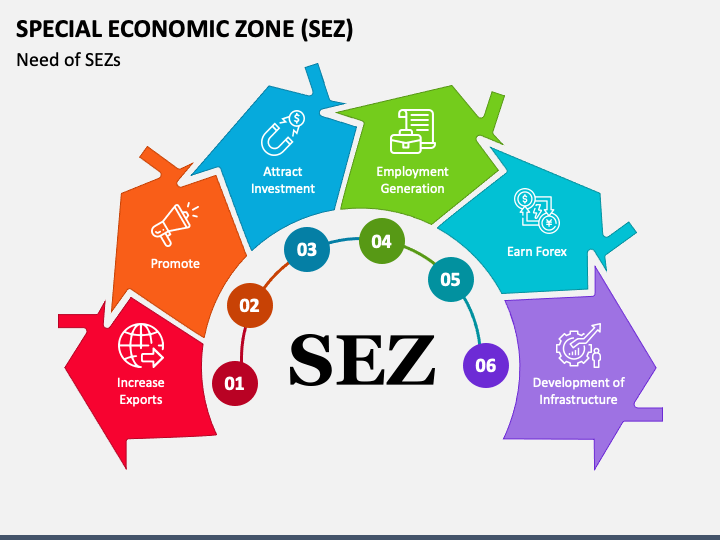
- Advancement of industrial technology through joint ventures and expertise exchange
In the modern world, advanced technology is a critical factor in the development of economy and the industrialization of a country. Fortunately, Pakistan is improving in technology sectors under CPEC as Chinese firms often conduct training sessions for Pakistani engineers, technicians and managers, boosting local technical skills and capacity. For example, Pak-China Technical and Vocational institute (Gwadar) offers technical and vocational training in fields like maritime and port management, software technology, tourism and many more. Moreover, Research and development centers in Special Economic Zones have promoted innovation. Thus, the partnership with Chinese firms leads to technology transfer and expertise exchange, equipping workers with specialized technical skills.
Critical Analysis
In critical diagnosis, Pakistan has been offered several opportunities through CPEC. It has helped address Pakistan’s chronic energy issues and has also projected its soft image at international level, attracting Foreign Direct Investment. However, Pakistan has not been able to reap the full benefits of this tremendous project due to several reasons, including security concerns, political instability, COVID- 19 and cumbersome bureaucratic procedures. For instance, CPEC’s Early Harvest Phase was expected to be completed in 2020 but faced delays due to Covid-19. Moreover, Chinese nationals, engineers and workers are being targeted In Pakistan raising security concerns for China. Nevertheless, Pakistan can maximize opportunities provided by CPEC if it is completed on time, supported by policy reforms and strategy measures. Thus, Pakistan needs to take pragmatic measures and focus on CPEC completion foster economic growth and industrialization.
Conclusion
In a nutshell, China and Pakistan, as all-weather friends, have deepened their bilateral relations through mutual cooperation. China has invested billions of dollars investment in Pakistan under CPEC, which is part of the broader BRI. The CPEC aims to connect China’s Xinjiang region with Pakistan’s Gwadar port, developing China’s underdeveloped western regions and increasing bilateral trade between the two countries. Moreover, it offers Pakistan to tackle its chronic problems, such as energy shortages, infrastructure gaps, low FDI and unemployment- and put its economy back on the track of sustainable development. CPEC also promotes regional connectivity linking Central Asia, Middle east, and beyond, strengthening Pakistan’s strategic position. Thus, CPEC has considerably transformed Pakistan’s economy and uplift its people’s standard of living.

CSS Solved Past Papers’ Essays
Looking for the last ten years of CSS and PMS Solved Essays and want to know how Sir Kazim’s students write and score the highest marks in the essays’ papers? Then, click on the CSS Solved Essays to start reading them.
CSS Solved Essays
CSS Solved Islamiyat Past Papers
Want to read the last ten years’ Islamiyat Solved Past Papers to learn how to attempt them and to score high? Let’s click on the link below to read them all freely. All past papers have been solved by Pakistan’s top CSS Islamiyat coach having the highest score of their students.
CSS Solved Islamiyat
CSS Solved General Science & Ability Past Papers
Want to read the last ten years’ General Science & Ability Solved Past Papers to learn how to attempt them and to score high? Let’s click on the link below to read them all freely. All past papers have been solved by Pakistan’s top CSS GSA coach having the highest score of their students.
CSS Solved General Science & Ability

